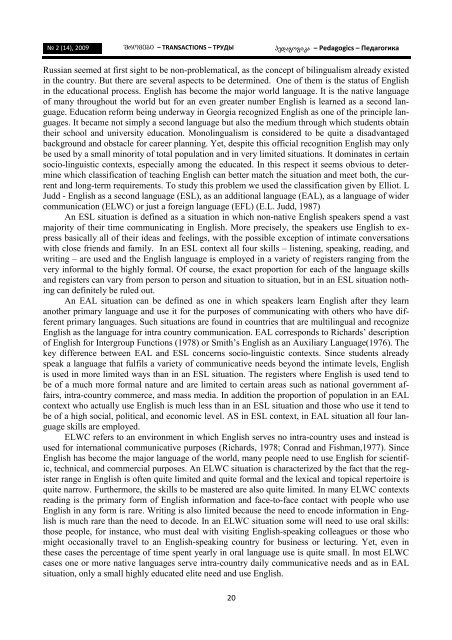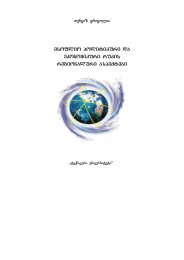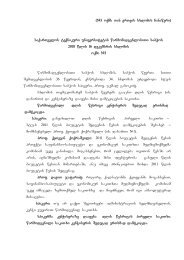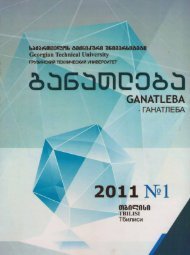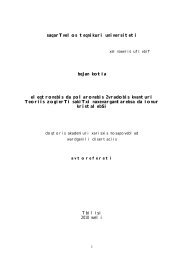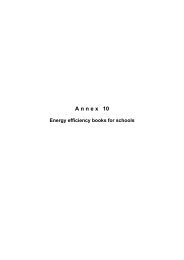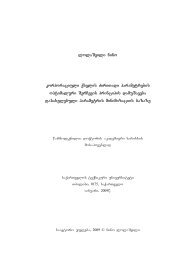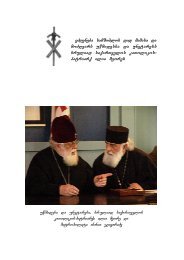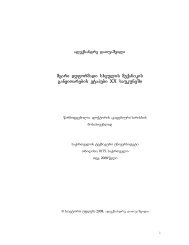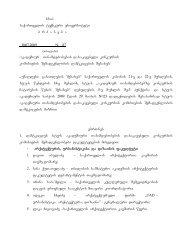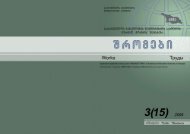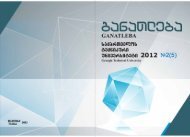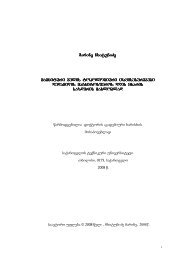Sromebi 2 (14) Works 2 (14) ТÑÑÐ´Ñ 2 (14) - Newsletters
Sromebi 2 (14) Works 2 (14) ТÑÑÐ´Ñ 2 (14) - Newsletters
Sromebi 2 (14) Works 2 (14) ТÑÑÐ´Ñ 2 (14) - Newsletters
Create successful ePaper yourself
Turn your PDF publications into a flip-book with our unique Google optimized e-Paper software.
№ 2 (<strong>14</strong>), 2009 <strong>Sromebi</strong> – TRANSACTIONS – ТРУДЫ pedagogika – Pedagogics – ПедагогикаRussian seemed at first sight to be non-problematical, as the concept of bilingualism already existedin the country. But there are several aspects to be determined. One of them is the status of Englishin the educational process. English has become the major world language. It is the native languageof many throughout the world but for an even greater number English is learned as a second language.Education reform being underway in Georgia recognized English as one of the principle languages.It became not simply a second language but also the medium through which students obtaintheir school and university education. Monolingualism is considered to be quite a disadvantagedbackground and obstacle for career planning. Yet, despite this official recognition English may onlybe used by a small minority of total population and in very limited situations. It dominates in certainsocio-linguistic contexts, especially among the educated. In this respect it seems obvious to determinewhich classification of teaching English can better match the situation and meet both, the currentand long-term requirements. To study this problem we used the classification given by Elliot. LJudd - English as a second language (ESL), as an additional language (EAL), as a language of widercommunication (ELWC) or just a foreign language (EFL) (E.L. Judd, 1987)An ESL situation is defined as a situation in which non-native English speakers spend a vastmajority of their time communicating in English. More precisely, the speakers use English to expressbasically all of their ideas and feelings, with the possible exception of intimate conversationswith close friends and family. In an ESL context all four skills – listening, speaking, reading, andwriting – are used and the English language is employed in a variety of registers ranging from thevery informal to the highly formal. Of course, the exact proportion for each of the language skillsand registers can vary from person to person and situation to situation, but in an ESL situation nothingcan definitely be ruled out.An EAL situation can be defined as one in which speakers learn English after they learnanother primary language and use it for the purposes of communicating with others who have differentprimary languages. Such situations are found in countries that are multilingual and recognizeEnglish as the language for intra country communication. EAL corresponds to Richards’ descriptionof English for Intergroup Functions (1978) or Smith’s English as an Auxiliary Language(1976). Thekey difference between EAL and ESL concerns socio-linguistic contexts. Since students alreadyspeak a language that fulfils a variety of communicative needs beyond the intimate levels, Englishis used in more limited ways than in an ESL situation. The registers where English is used tend tobe of a much more formal nature and are limited to certain areas such as national government affairs,intra-country commerce, and mass media. In addition the proportion of population in an EALcontext who actually use English is much less than in an ESL situation and those who use it tend tobe of a high social, political, and economic level. AS in ESL context, in EAL situation all four languageskills are employed.ELWC refers to an environment in which English serves no intra-country uses and instead isused for international communicative purposes (Richards, 1978; Conrad and Fishman,1977). SinceEnglish has become the major language of the world, many people need to use English for scientific,technical, and commercial purposes. An ELWC situation is characterized by the fact that the registerrange in English is often quite limited and quite formal and the lexical and topical repertoire isquite narrow. Furthermore, the skills to be mastered are also quite limited. In many ELWC contextsreading is the primary form of English information and face-to-face contact with people who useEnglish in any form is rare. Writing is also limited because the need to encode information in Englishis much rare than the need to decode. In an ELWC situation some will need to use oral skills:those people, for instance, who must deal with visiting English-speaking colleagues or those whomight occasionally travel to an English-speaking country for business or lecturing. Yet, even inthese cases the percentage of time spent yearly in oral language use is quite small. In most ELWCcases one or more native languages serve intra-country daily communicative needs and as in EALsituation, only a small highly educated elite need and use English.20


